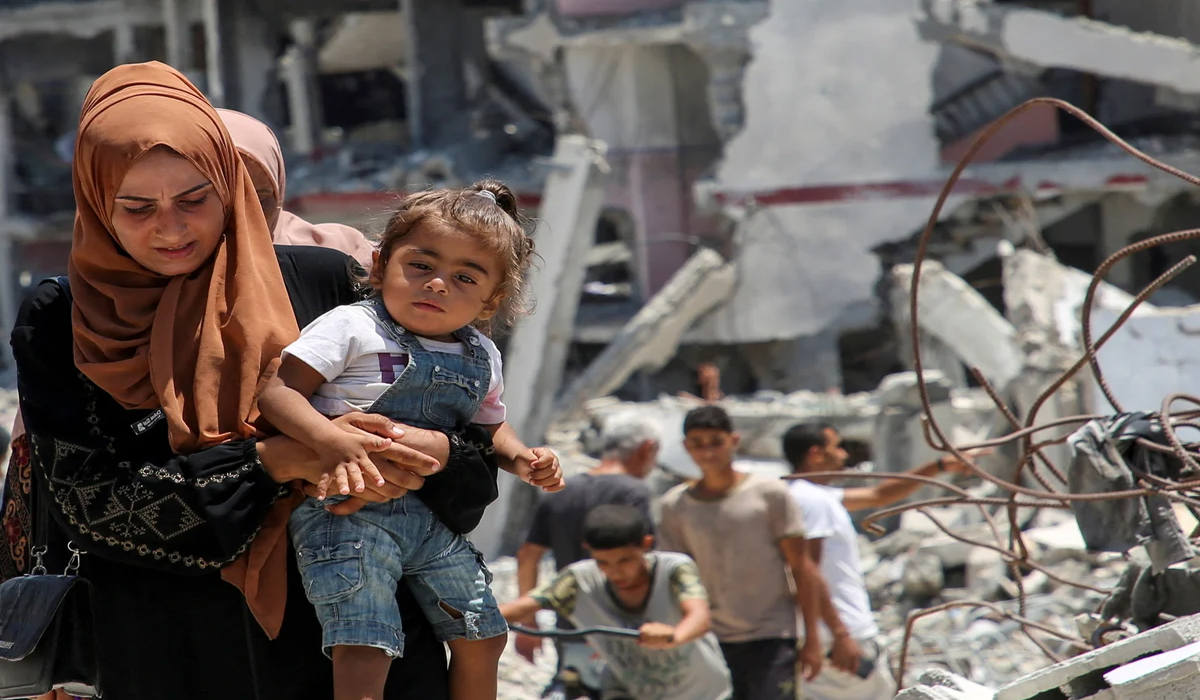
On Wednesday morning, Israelis across the country paused in unison at 6:29 am — the precise moment on October 7, 2023, when Hamas launched its devastating assault — to mark 600 days since the attack and to call for the return of hostages still held in Gaza. In a series of synchronized demonstrations, families of the captives and their supporters gathered in cities and symbolic locations, turning the moment into a national act of remembrance and protest. In Tel Aviv, demonstrators formed a human chain representing the now-iconic yellow ribbon — a symbol of hope and solidarity for the hostages — while others wore yellow shirts and released yellow balloons into the sky.
At Hostages Square, participants stood in a solemn circle, watching as a digital display, which has been counting the duration of the hostages’ captivity, ticked over from 599 to 600 days. The emotional scene unfolded in silence, broken only by sobs and personal tributes from family members of those abducted. One father of a victim, addressing the crowd, expressed the anguish felt by so many. “Go out on your porch and look at us. Our children were killed and assaulted on October 7. For 600 days, you have turned away from us. We won’t let this break us, and we’ll continue to fight.”
His words were directed not only to government officials but to all citizens, as a call to remain engaged and vocal in demanding action. Another powerful gathering occurred near the U.S. Embassy in Tel Aviv, where demonstrators etched the numbers “58” and “600” — representing the number of known hostages and the days since the conflict began — into the sand, alongside the phrase “Save Them Now.”
The imagery captured the dual message of the protest: a demand for urgency and a tribute to the perseverance of families still clinging to hope. These coordinated actions were a response not only to the prolonged crisis of the hostages but also to the broader toll of the ongoing war between Israel and Hamas.
Since the initial surprise attack, which left more than 1,200 Israelis dead and saw the abduction of over 250 people, the conflict has continued with devastating consequences on both sides. While many hostages were released through negotiated swaps late last year, dozens still remain in Hamas custody, and their fates are largely unknown. Prime Minister Benjamin Netanyahu addressed the hostage issue earlier this week, reiterating h i s g o v e r n m e n t ’s determination to secure their return.
“We intend to bring them all back, the living and the dead,” he declared, underscoring that Israel’s commitment remains firm, though he provided no new timeline or details of ongoing negotiations. “If we don’t achieve it today, we will achieve it tomorrow, and if not tomorrow, then the day after. We are not giving up.” Despite Netanyahu’s assurances, many families of the hostages feel frustrated by the lack of progress and transparency. Criticism has mounted over the government’s perceived unwillingness to consider truce officers or prisoner swaps that might accelerate the return of the captives. “We’re stuck in a political deadlock while our loved ones suffer,” said one protester in Jerusalem.
“The leadership talks about victory, but what we need is compassion and action.” On the diplomatic front, confusion and contention clouded recent ceasefire discussions. Hamas announced on Monday that it had accepted a new truce proposal reportedly brokered by U.S. envoy Steve Witkoff, yet Witkoff’s office later denied that any agreement had been reached. The miscommunication highlights the fragile nature of negotiations, where even minor misunderstandings can derail critical humanitarian efforts. While the diplomatic c h a n n e l s r e m a i n uncertain, a humanitarian breakthrough did occur in Gaza this week, where a U.S.-supported aid group resumed food distribution operations. This follows days of halted aid deliveries due to security concerns and logistical obstacles. The new distribution system, developed in cooperation with Israeli authorities, is designed to streamline aid delivery while preventing interference by militant groups.
However, scenes of chaos erupted as thousands of desperate Gazans rushed to the aid centres, hoping to receive food for their families. Some aid workers described the atmosphere as tense and overwhelming, with crowds forming hours before the distribution began. The situation underscores the extreme conditions faced by civilians in Gaza, many of whom are living without consistent access to food, water, or electricity. Human rights organizations and aid agencies continue to urge all parties involved in the conflict to prioritize humanitarian needs and protect civilians.
The UN has repeatedly warned that the humanitarian crisis in Gaza is deepening, and any delay in delivering aid could result in further suffering and loss of life. Meanwhile, Israeli officials continue to emphasize their security concerns, arguing that Hamas has repeatedly exploited ceasefires to regroup and rearm.
Yet for the families of hostages and the broader Israeli public, the desire to see their loved ones return home is becoming increasingly urgent. The 600-day mark has become more than just a grim milestone. It is now a symbol of national endurance, collective grief, and the widening gap between promises and outcomes. The question echoing across Israel remains: how much longer must families wait? As the sun rose on this day of protest and remembrance, the message was unmistakable — the hostages are not forgotten, and their families, supported by thousands of citizens, will continue to raise their voices until justice is served and every captive is brought home.
